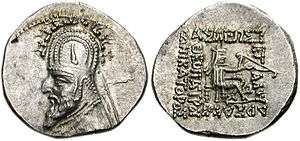Sanatruces of Parthia

King Sanatruces of Parthia (Persian: سیناتروک) (also Sinatruces or Sanatruk, c. 157 BC – 70 BC) ruled the Parthian Empire from c. 93/2 BC to 88/87 BC during his first reign and c. 77 to 70 BC during his second reign. He was a member of the Arsacid house, who proclaimed himself king in Susiana and attempted to usurp the throne of Mithridates II.[1] Ultimately, Gotarzes I forced him to flee to the Central Asian steppe. Years later, according to work attributed to Lucian, he regained the throne with the aid of the Sacaraucae Scythians or Saka, an Indo-European tribe akin to the Parthians who had invaded Iran in about 77 BC.[2][3]
- "Sinatroces, king of Parthia, was restored to his country in his eightieth year by the Sacauracian Scyths, assumed the throne and held it seven years." Makrobioi, 15.[4]
He died c. 70 BC[5] and was succeeded by his son Phraates III.[6]
Sanatruces in Byzantine tradition
Another Sanatruces (Sanatrucius), the son of Mithridates IV is mentioned as an ephemeral Parthian king in 115 AD by John Malalas, in his Chronographia.
Notes
- ↑ "Assar 2005" 53-5
- ↑ "Les villes du sud-ouest de l'Afghanistan. C. Baratin. In: Afghanistan, ancien carrefour entre l'est et l'ouest, p. 181, ISBN 2-503-51681-5
- ↑ "The Commerce of Kapisene and Gandhāra after the Fall of Indo-Greek Rule." K. Walton Dobbins. Journal of the Economic and Social History of the Orient, Vol. 14, No. 3 (December , 1971), p. 286.
- ↑ The Makrobioi or 'Long Life'.
- ↑ Grousset, Rene (1970). The Empire of the Steppes. Rutgers University Press. p. 31. ISBN 0-8135-1304-9.
- ↑ The Parthians, p. 35. (1967). Malcolm A. R. Colledge. Frederick A. Praeger, New York; Washington.
References
 This article incorporates text from a publication now in the public domain: Chisholm, Hugh, ed. (1911). "article name needed". Encyclopædia Britannica (11th ed.). Cambridge University Press.
This article incorporates text from a publication now in the public domain: Chisholm, Hugh, ed. (1911). "article name needed". Encyclopædia Britannica (11th ed.). Cambridge University Press.- Lucian, Macrobii, 15;
- Phlegon of Tralles, The Olympiads, preserved in Photius, Bibliotheca, 97.
- Appian, Mithridates, 104.
- Dio Cassius, xxxvi. 45.
| Sanatruces of Parthia Born: 157 BC Died: 70 BC | ||
| Preceded by Orodes I (80 BC) ... Unknown ruler |
Great King (Shah) of Parthia 77–70 BC |
Succeeded by Phraates III |